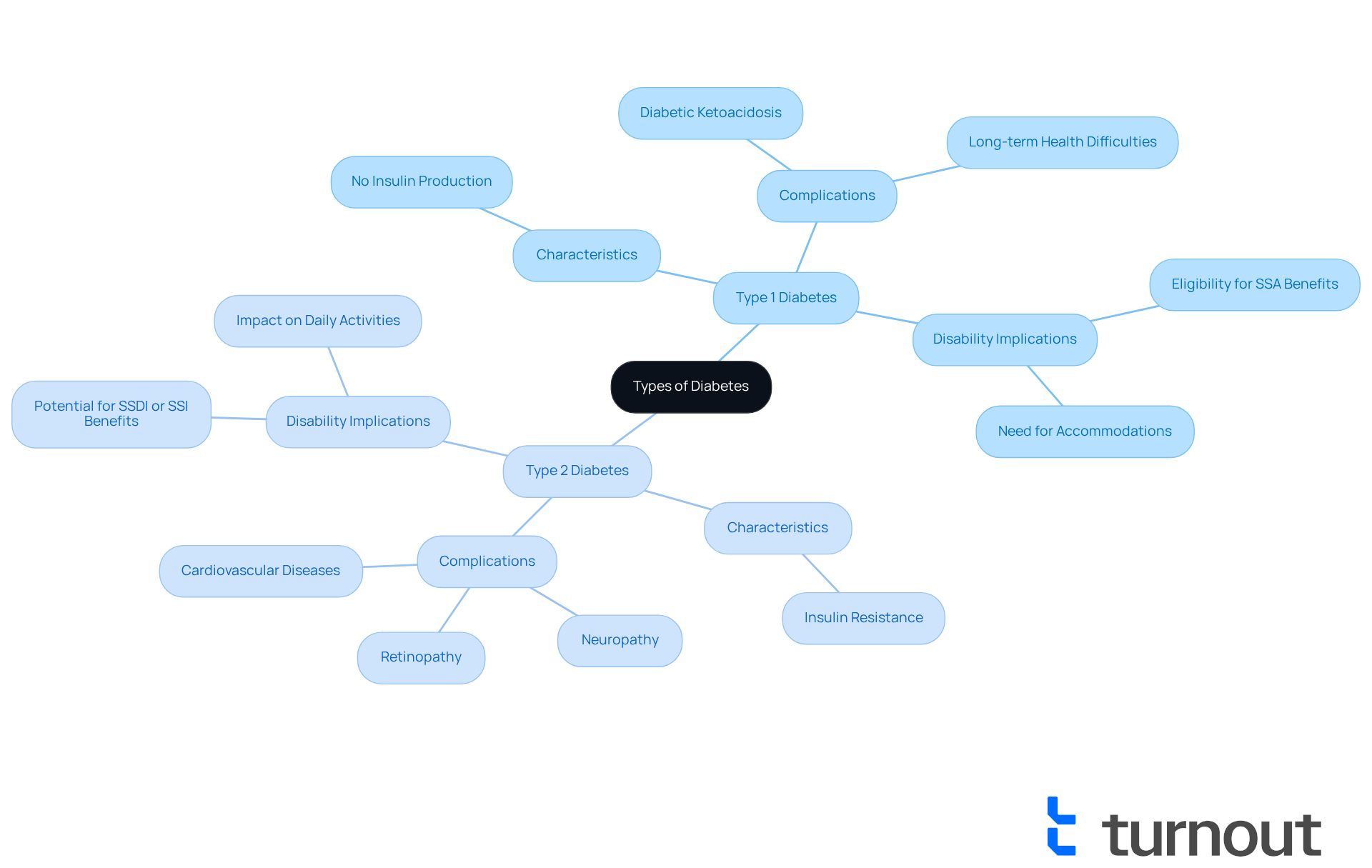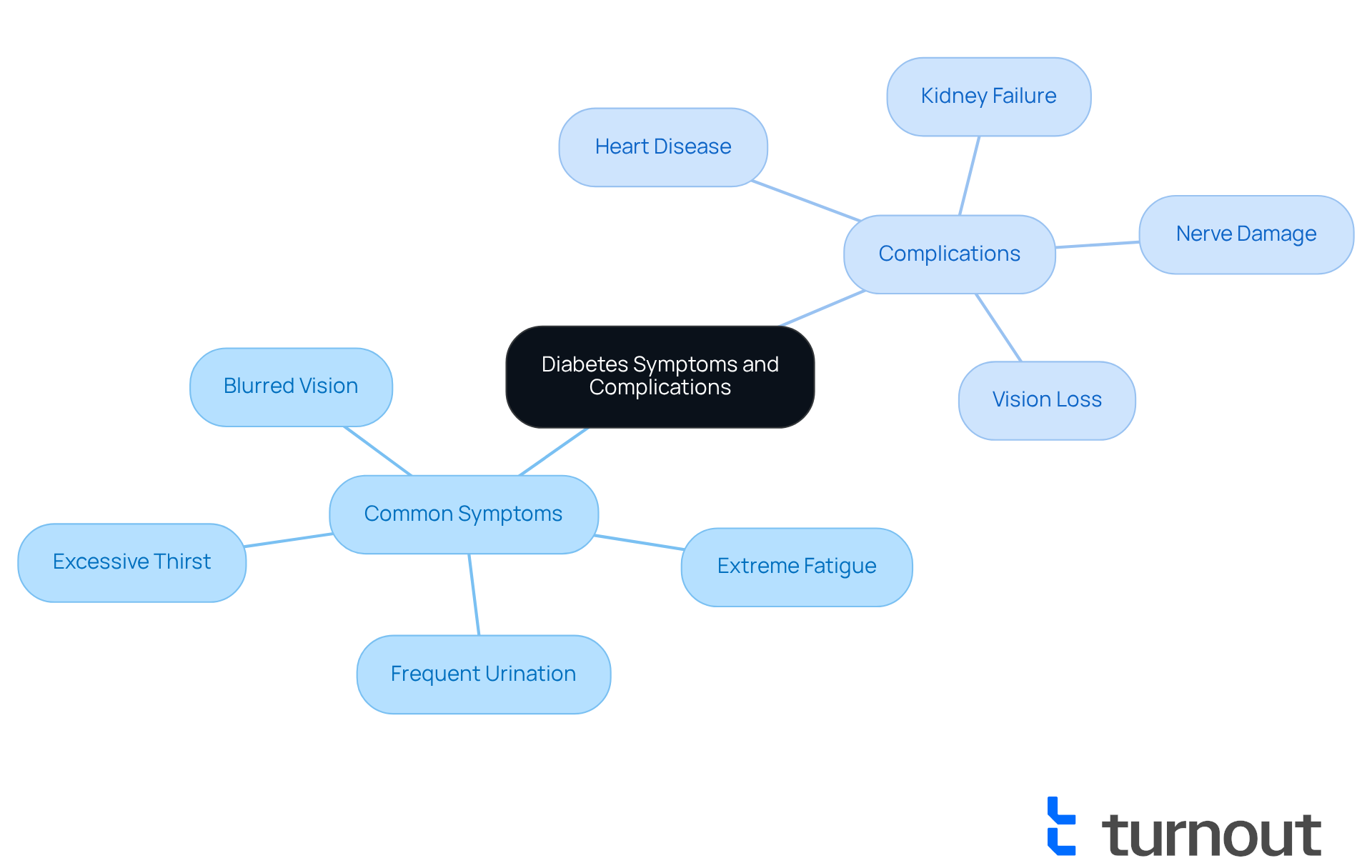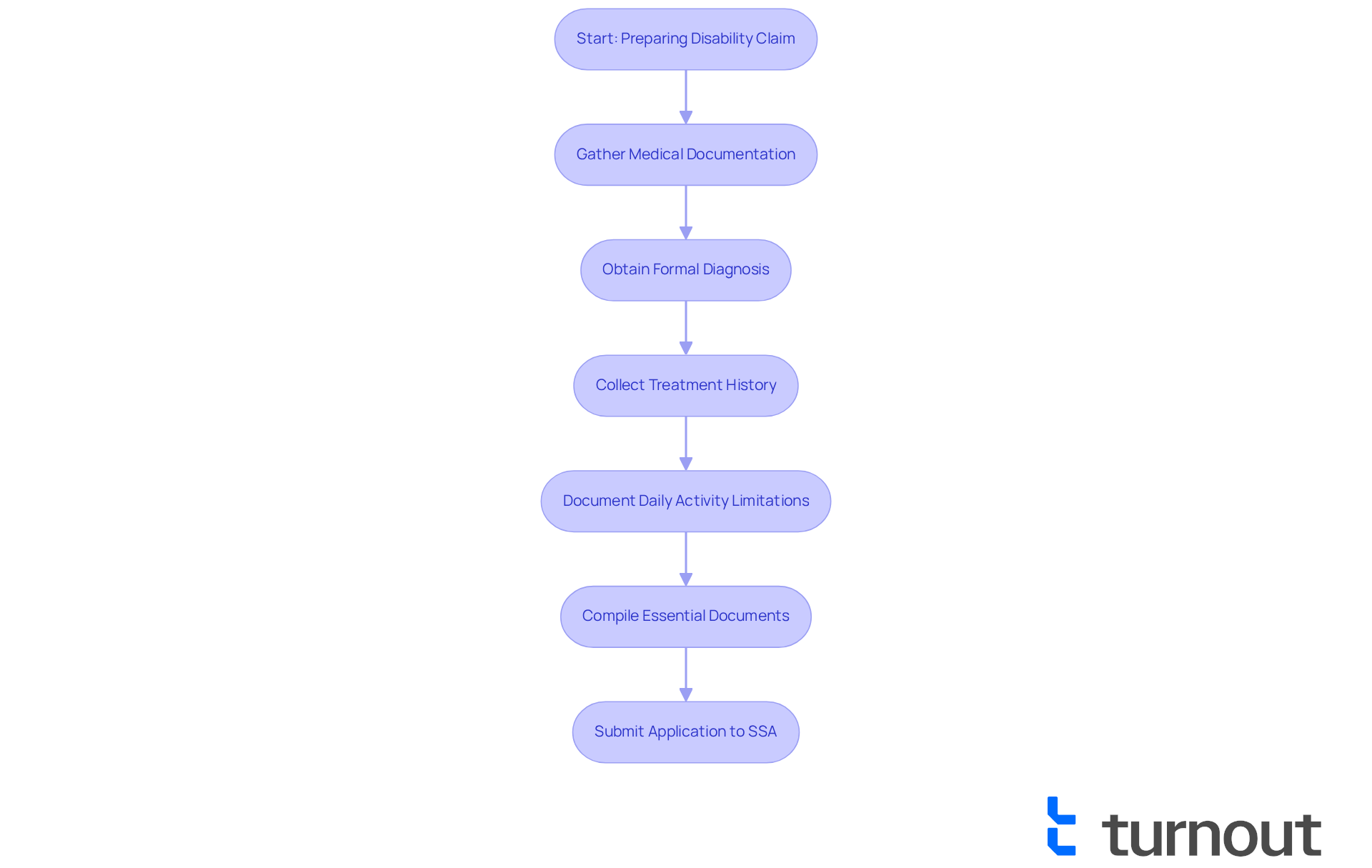Overview
Navigating diabetes disabilities can be a challenging journey, and we understand the emotional toll it can take on daily life. This article serves as a comprehensive guide, shedding light on the impact of diabetes, the various types, symptoms, and essential management strategies for securing disability benefits.
It's crucial to document your experiences thoroughly and implement effective management techniques, such as healthy eating and regular exercise. These steps can significantly improve your health outcomes and support your claims for assistance. Remember, you are not alone in facing the multifaceted challenges that come with living with diabetes.
We encourage you to take action by prioritizing your health and seeking the support you deserve. With the right tools and information, you can navigate this journey with confidence and resilience.
Introduction
Diabetes is more than just a medical condition; it profoundly influences daily life, affecting everything from work productivity to social interactions. We understand that individuals grappling with diabetes often face a myriad of challenges, including:
- Dietary restrictions
- Frequent medical appointments
- The constant need to monitor blood glucose levels
As the complexities of managing diabetes unfold, one might wonder: how can you effectively navigate these obstacles while advocating for your rights and securing the support you need?
This guide delves into the nuances of diabetes disabilities, offering essential insights and strategies for those seeking to understand and manage their condition. You're not alone in this journey; we're here to help.
Define Diabetes and Its Impact on Daily Life
Diabetes is a long-term condition that can feel overwhelming, characterized by increased blood glucose levels due to the body's struggle to produce or effectively use insulin. We understand that diabetes disabilities can profoundly affect daily life, leading to challenges in health management, work, and social interactions. Many individuals face dietary limitations, frequent medical visits, and the ongoing need to track blood glucose levels. These factors can lead to increased stress and anxiety, making it difficult to perform daily tasks and maintain employment.
For instance, you might need to adjust your work schedule to accommodate medical appointments or find it challenging to concentrate due to fluctuations in your blood sugar levels. Statistics show that individuals with type 2 diabetes who are not using insulin experience an 11% decline in work productivity, while those using insulin see a 19% decrease. Such challenges associated with diabetes disabilities can significantly hinder job performance, making it essential to document these effects when seeking assistance benefits.
Real-world experiences further highlight these impacts. Many people report feeling overwhelmed by the constant need to manage their condition, leading to feelings of isolation and difficulty in social situations. As one health expert emphasized, addressing both physical and mental well-being is crucial for effectively managing diabetes. This holistic approach can enhance overall well-being and improve your ability to navigate daily activities, including work responsibilities.
Understanding the implications of diabetes disabilities is vital for anyone considering disability claims. It underscores the real-world difficulties of living with diabetes. Remember, you are not alone in this journey, and we’re here to help you find the support you need.

Explore Types of Diabetes and Their Disability Implications
Diabetes is classified into two primary types: Type 1 and Type 2. We understand that navigating diabetes can be challenging, especially when it comes to understanding these types.
-
Type 1 diabetes mellitus, usually identified during childhood, occurs when the body does not generate insulin. Individuals with Type 1 may encounter serious issues, such as diabetic ketoacidosis, which can require hospitalization and lead to long-term health difficulties.
-
On the other hand, Type 2 diabetes is more prevalent among adults and is characterized by insulin resistance. It's common to feel overwhelmed, but many individuals can manage Type 2 through lifestyle changes. However, some still face complications like neuropathy, retinopathy, and cardiovascular diseases.
Both types of diabetes disabilities may qualify for assistance if their complications significantly hinder daily activities.
For instance, an individual with Type 2 may encounter mobility challenges due to neuropathy, greatly impacting their ability to engage in physical activities at work. Understanding the differences between these two categories is crucial for accurately conveying the severity of the condition in claims related to impairments.
Data suggest that significant health issues related to diabetes disabilities are a common reason for disability claims. This emphasizes the necessity of comprehensive documentation and medical proof in the application process. Remember, you are not alone in this journey, and we're here to help you navigate these challenges.

Identify Symptoms and Complications of Diabetes
Common symptoms of this condition include excessive thirst, frequent urination, extreme fatigue, and blurred vision. We understand that living with diabetes can be challenging. If not properly managed, diabetes can lead to serious issues such as:
- Heart disease
- Kidney failure
- Nerve damage
- Vision loss
These complications can significantly obstruct your capacity to work and perform everyday tasks, particularly for those facing diabetes disabilities.
For instance, diabetic neuropathy may result in pain and numbness in your extremities, making it difficult to walk or stand for prolonged periods. Likewise, retinopathy can hinder your sight, impacting activities that require precise visual clarity. It's important to know that data show 60% of people diagnosed with diabetes encounter at least one issue within 15 years. Many face multiple challenges that can interfere with their daily lives.
Recording these symptoms and issues is essential when seeking assistance benefits. They provide critical proof of how diabetes affects your everyday activities and work ability. Understanding these challenges associated with diabetes disabilities can empower you to advocate for your rights and seek the support you need. Remember, you are not alone in this journey; we're here to help.

Understand Diagnosis and Documentation for Disability Claims
Navigating the process of qualifying for disability benefits can be challenging, and we understand that it often feels overwhelming. To secure these vital benefits, individuals with the condition are required to submit thorough medical documentation. This includes a formal diagnosis, treatment history, and evidence of how the ailment limits daily activities. Essential documents typically consist of medical records, lab results, and statements from healthcare professionals that outline the severity of the condition and its associated challenges.
For instance, a healthcare provider may need to illustrate how diabetes affects an individual's ability to perform work-related tasks, such as lifting, standing, or concentrating. Keeping a comprehensive record of blood sugar levels, symptoms, and any complications can significantly strengthen a claim for assistance. Remember, you are not alone in this journey; many have faced similar hurdles and found ways to overcome them.
Understanding the specific requirements set forth by the Social Security Administration (SSA) is crucial for ensuring that all necessary information is included in your application. It's common to feel anxious about this process, especially when statistics show that up to 80% of first-time applications for disability benefits are rejected. This underscores the importance of comprehensive documentation. By being well-prepared and informed about the SSA's expectations, you can enhance your chances of a successful claim. We're here to help you every step of the way.

Implement Management Strategies for Diabetes
Effectively managing diabetes requires a multifaceted approach that combines lifestyle changes, medication adherence, and consistent monitoring. We understand that navigating this journey can be challenging, but there are key strategies that can help you feel more in control:
-
Healthy Eating: Emphasize a balanced diet that includes whole grains, lean proteins, fruits, and vegetables, while reducing sweeteners and processed foods. Recent guidelines advocate for sustainable eating patterns, such as plant-based diets, which can significantly impact blood sugar control. As per the 2025 ADA Standards of Care, following a nutritious diet can lower the risk of health issues related to high blood sugar by as much as 40%.
-
Regular Exercise: Aim for at least 150 minutes of physical activity each week. We know that consistent physical activity improves insulin sensitivity and aids in overall health advancements, which are essential for managing diabetes-related conditions. The CDC emphasizes that engaging in regular physical activity can lower the risk of serious diabetes complications.
-
Blood Glucose Monitoring: Consistently check blood glucose levels to gain insights into how various factors—such as diet, physical activity, and stress—affect glucose levels. This practice is essential for making informed decisions about daily management. A study discovered that participants who consistently tracked their blood glucose levels reported improved management of their condition.
-
Medication Adherence: Following prescribed medication regimens diligently is crucial for maintaining optimal blood sugar levels. Adherence to medication is a critical component of effective management of blood sugar conditions. Marcia Ory, a leading researcher in diabetes care, states that consistent medication adherence is vital for preventing complications.
-
Stress Management: Incorporate relaxation techniques, such as yoga or meditation, to alleviate stress, which can negatively impact blood glucose regulation. Research indicates that managing stress effectively can lead to improved blood sugar levels and overall health.
Implementing these strategies not only improves health outcomes but may also influence the severity of diabetes disabilities, potentially enhancing the chances of successful disability claims. Real-world examples demonstrate that individuals who adopt these lifestyle changes often report better management of their condition, leading to improved quality of life and increased eligibility for benefits. Remember, you are not alone in this journey, and we’re here to help you take these important steps toward better health.

Conclusion
Navigating the complexities of diabetes and its associated disabilities can feel overwhelming. We understand that this condition impacts not just physical health, but also mental well-being and overall quality of life. Recognizing these challenges is essential for anyone seeking support in managing their condition effectively.
Throughout this journey, we’ve highlighted key points, including:
- The distinctions between Type 1 and Type 2 diabetes
- The symptoms and complications that can arise
- The critical importance of thorough documentation when applying for disability claims
Strategies for effective diabetes management—such as healthy eating, regular exercise, and stress management—are vital. These practices not only improve health outcomes but may also enhance eligibility for benefits.
Ultimately, understanding the multifaceted nature of diabetes and its disabilities is crucial for anyone affected by this condition. It’s not just about managing blood sugar levels; it’s about advocating for yourself and seeking the necessary support to navigate life’s challenges. By implementing effective management strategies and ensuring proper documentation, you can empower yourself and work toward a healthier future.
Remember, the journey may be tough, but you are not alone. There are resources and communities ready to offer support every step of the way. Together, we can face these challenges and strive for a brighter tomorrow.
Frequently Asked Questions
What is diabetes and how does it impact daily life?
Diabetes is a long-term condition characterized by increased blood glucose levels due to the body's difficulty in producing or using insulin. It can lead to challenges in health management, work, and social interactions, causing dietary limitations, frequent medical visits, and the need to track blood glucose levels, which can result in increased stress and anxiety.
How does diabetes affect work productivity?
Individuals with type 2 diabetes who are not using insulin experience an 11% decline in work productivity, while those using insulin see a 19% decrease. These challenges can significantly hinder job performance and make it essential to document these effects when seeking assistance benefits.
What are the emotional impacts of living with diabetes?
Many individuals with diabetes report feeling overwhelmed by the constant management of their condition, leading to feelings of isolation and difficulty in social situations. Addressing both physical and mental well-being is crucial for effectively managing diabetes.
What are the two primary types of diabetes?
The two primary types of diabetes are Type 1 and Type 2. Type 1 diabetes is usually identified during childhood and occurs when the body does not produce insulin. Type 2 diabetes, more prevalent among adults, is characterized by insulin resistance.
What complications can arise from Type 1 and Type 2 diabetes?
Individuals with Type 1 diabetes may face serious issues like diabetic ketoacidosis, while those with Type 2 diabetes can experience complications such as neuropathy, retinopathy, and cardiovascular diseases.
Can diabetes disabilities qualify for assistance?
Yes, both types of diabetes disabilities may qualify for assistance if their complications significantly hinder daily activities. It's important to document the severity of the condition for claims related to impairments.
Why is comprehensive documentation important for disability claims related to diabetes?
Significant health issues related to diabetes disabilities are a common reason for disability claims, emphasizing the necessity of comprehensive documentation and medical proof in the application process.




